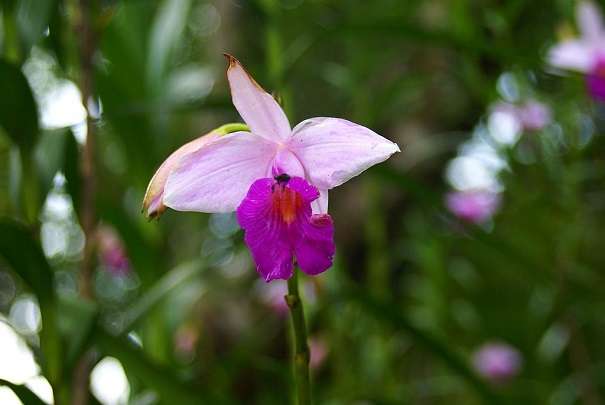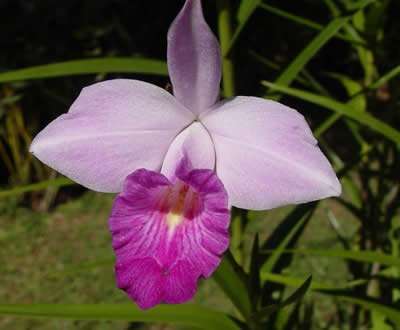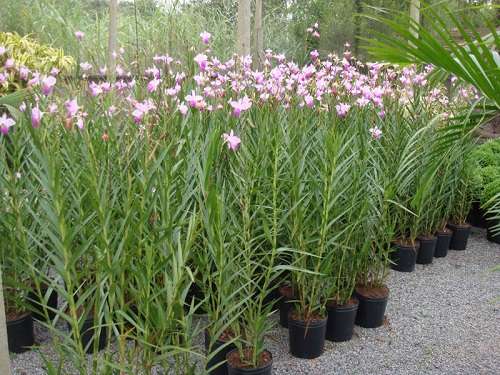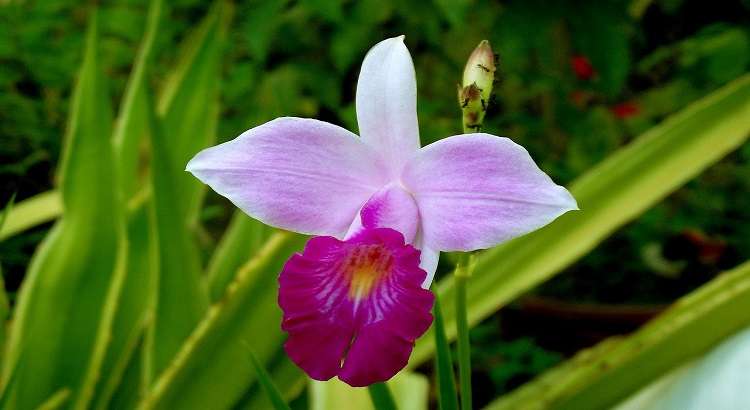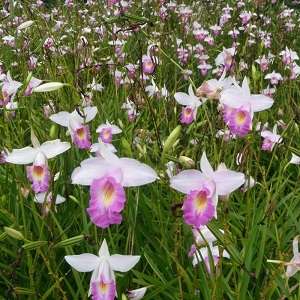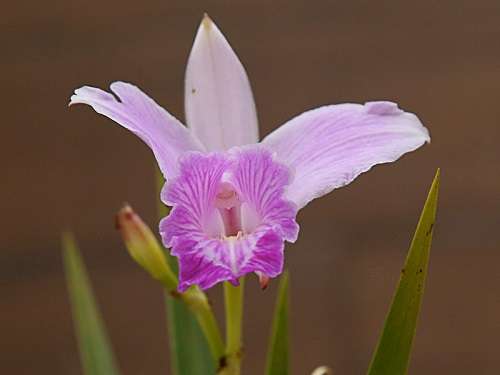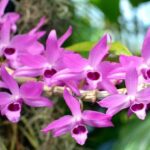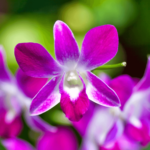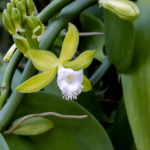The bamboo orchid or Arundina graminifolia (scientific name) is a ground orchid native to Southeast Asia that can grow up to 2.5 meters (98 inches) in height.
Well known for its resemblance to bamboo, it can be found in the following countries:
- India
- Nepal
- Thailand
- Malaysia
- Singapore
- China
Keep reading, because in this article, you’ll learn more about its flowers and how to care for this orchid.
Fun fact: This orchid is nearly extinct in its natural habitat, but thanks to its commercial value, it can be found in almost any orchidarium.
Learn How to Achieve Super Blooms on Your Orchids
🛑 If you love orchids and you're tired of not being able to make them bloom...
Then, know that thousands of beginner growers are achieving beautiful flowers on their orchids by following this method.
Click the button below to have beautiful orchids with show-worthy flowers every year. ⤵
Flowers
Unlike most orchids, the bamboo orchid does not have a fixed flowering season.
It produces several short blooms throughout the year, lasting between 3 to 7 days.
Here are some characteristics of its flowers:
- They are approximately 9 cm (3.5 inches) long
- Fragrant, attracting various animals such as bees, beetles, and butterflies
- Come in various shades, with lilac and white being the most common
To make this orchid bloom, you need to cultivate it correctly. The section below will help you take care of this orchid.
How to Care for the Bamboo Orchid
This is probably one of the most resistant and easy-to-cultivate orchids.
Like most terrestrial orchids, this plant requires plenty of light and is incredibly sun-resistant.
Despite its easy care, there are some special precautions to ensure this orchid blooms.
Especially if you are used to cultivating other orchid species, as the cultivation of Arundina is different from most other orchids.
1. Where to Cultivate
The first factor to consider is the location where your orchid will be placed.
It should receive full sun all day, as it does not like to be in the shade for too long.
The climate should be warm, so the bamboo orchid is not recommended for the southern region.
It does not tolerate frost, and the wind should not be too strong, as it can knock off its flowers.
After finding a location that meets these criteria, let’s find out where is the best spot to plant Arundina graminifolia.
2. Where to Plant
This tip applies to Arundina as well as many other terrestrial orchids, such as Paphiopedilum or lady’s slipper orchids.
Terrestrial orchids are found on the ground, so they should not be placed in significantly different environments.
If you plant your terrestrial orchid in the following places, it will die:
- Trees
- Attached to tree trunks
Therefore, the best places to plant this orchid are:
- Deep pots
- Soil (with plenty of organic matter)
If you want to plant it in your garden or flower bed, don’t worry, they will thrive.
3. Potting Mixes for Arundina
Before planting your orchid, you need to know what to put in the pot.
These mixtures are called potting mixes.
For bamboo orchids, potting mixes help them obtain energy, so some excellent options are:
- Soil
- Sand (avoid using too much, as it can heat up the roots)
- Humus
- Organic compounds
Basically, the soil should be rich in organic matter and permeable for the roots to grow, with good drainage.
4. Watering
The bamboo orchid is a plant that loves water.
During the summer, especially on the hottest days, it should be watered daily.
On slightly cooler days, water every other day.
Watering should be done when the soil is dry, but be careful not to overwater.
Also, water in the morning, as the sun is not too strong yet.
5. How to Propagate Bamboo Orchid
There are several ways to propagate orchids, some are more complicated than others.
In the case of the bamboo orchid, the simplest way to propagate it is through generating keikis (seedlings).
After it produces its first keiki, follow these tips:
- Wait for them to have at least 2 or 3 roots before removing them from the plant
- Plant them in a pot with sphagnum moss or in the soil with suitable potting mixes and place them in a slightly shaded area (not too much)
- Take care of them until they produce their first flowers (usually in 1 or 2 years)
Orchids usually produce keikis when they are healthy, so before worrying about reproducing your plant, make sure to cultivate it correctly.
> Another method of reproduction is by seeds, but it is more time-consuming and complicated because the seeds are very small and difficult to cultivate.
Do You Want to Learn How To Keep Your Orchids Healthy And Ready to Bloom Every Year?
So, I prepared a complete guide, step by step and illustrated, that will show you:
• The secrets to getting beautiful flowers every year
• How to fight and identify pests and diseases on your orchids
• THE MAGIC SUBSTANCE for orchids and how to use it
• And much, much more.
The great news is that the manual is now available at a super discount!!
But beware, it's only for the first buyers.
Click on MORE INFORMATION below and discover the secrets to show-worthy flowers. 👇
6. How to Fertilize
Terrestrial orchids generally respond well to fertilization.
But be very careful with excessive fertilization, as it can cause spots on your orchid leaves.
We recommend two types of fertilization for your bamboo orchid:
- Organic: every 2 months
- Chemical: with NPK 10-52-10, which helps in flowering and rooting of your orchid (use when it’s small)
7. Lighting
Lighting is one of the most important factors in cultivating this orchid. If you do not provide this factor correctly, it will not be healthy.
Unlike other plants like phalaenopsis or vanda, it can tolerate direct sunlight.
Yes, the bamboo orchid should be cultivated in direct sunlight.
If it is placed in very shaded areas, it will bend in search of sun, giving it an unattractive appearance.
It also adapts to partial shade, but this is not recommended in most cases.
8. Temperature
As mentioned earlier, the bamboo orchid is a plant that loves light.
Regarding temperature, it is a tropical orchid.
Therefore, it is ideal that you provide temperatures ranging from 25°C to 30°C (77°F to 86°F) for your orchid.
They can also withstand slightly higher or lower temperatures for a short period.
But if possible, avoid this.
NOTE: During the night, the temperature will drop slightly, but you should only worry in the case of frost.
9. Pruning
Pruning is done on orchids to ensure good flowering the following year.
In the case of Arundina, you will prune it after flowering, when its flowers have fallen.
During this procedure, you will only remove the older flower spikes from your orchid.
10. Common Problems
Like any other plant, this orchid can also suffer from pest attacks, diseases, and fungi.
Here are 2 of the most common problems that can affect your Arundina graminifolia:
- Yellowing leaves: lack of nutrients, excessive sun, or lack of water
- Round spots: usually fungi, use fungicides to combat them
Conclusion – Arundina graminifolia
The bamboo orchid is one of the most famous among orchid growers.
It is very beautiful and can be used to decorate various gardens and yards.
If you want to learn more about terrestrial orchids and how to cultivate them, I recommend that you read the following articles:
- Phragmipedium Orchids – How to Care in 7 Steps
- Orchid Care for Beginners: Quick and Easy 7-Step Guide
And if you enjoyed this article, leave your comment below; I really want to know your story with Arundina.

